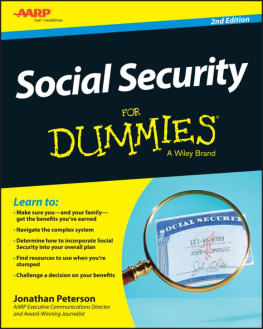Foreword
On the back cover we state: For most people, Social Security is their largest financial asset, worth hundreds of thousands of dollars and indexed against increases in the cost of living.
We also say: This book may be worth tensor even hundredsof thousands of dollars to you!
Heres how:
The average monthly benefit in 2019 is $1,461. In order to generate that amount of income, you would have to have $876,600 in the bank earning a 2% annual return.
The average life expectancy of a 65-year-old is now 20 years. At the average of $1,461 a month, that comes to $350,640 in lifetime benefits. (And this does not include the increase from the cost-of-living adjustments.)
The two main ways you can lose Social Security retirement benefits are failure to apply for benefits that you are eligible for, and not maximizing your benefits.
Folks are almost always aware of the benefits due to them based on their own work record. Where the money is usually lost is on the auxiliary benefits, especially spousal (married people, divorced, and survivors). If this book makes you aware of your eligibility for benefits on someone elses work record, that could be very valuable information indeed!
About 40 percent of all retirees take their benefits at age 62, their first opportunity. They may not know that their monthly benefit will be 76 percent larger if they can hold off until they are 70. Waiting those eight years can generate an extra $1,000 a month for the rest of your life. If you live into your late eighties, or nineties (or your spouse does), waiting to collect can be one of the best investments you will ever make.
Chapter One
Background
What are the purposes of Social Security?
What programs are included under Social Security?
How large is Social Security?
How do Social Security benefits and Supplemental Security Income (SSI) payments differ?
How is Social Security financed?
What are FICA and SECA taxes?
What is the current maximum amount of Taxable Earnings for Social Security this year? How has the Maximum Taxable Earnings changed over the years?
Do I own the money I pay in Social Security taxes?
What is the Old-Age and Survivors Insurance (OASI) Trust Fund?
1. What are the purposes of Social Security?
The Social Security Act and related laws establish a number of programs that have the following basic purposes:
To provide for the material needs of individuals and families;
To protect aged and disabled persons against the expenses of illness that may otherwise use up their savings;
To keep families together; and
To give children the chance to grow up healthy and secure.
2. What programs are included under Social Security?
The following programs are included:
Retirement insurance;
Survivors insurance;
Disability insurance;
Hospital and medical insurance for the aged, the disabled, and those with end-stage renal disease;
Prescription Drug Benefit;
Extra help with Medicare Prescription Drug Costs;
Supplemental security income;
Special Veterans Benefits;
Unemployment insurance; and
Public assistance and welfare services, including:
Temporary assistance for needy families;
Medical assistance;
Maternal and child health assistance;
Child support enforcement;
Family and child welfare services;
Food stamps; and
Energy assistance.
[EDITORS NOTE: This book deals ONLY with the first two programs listed above: RETIREMENT and SURVIVORS INSURANCE.]
3. How large is Social Security?
In 2017, over 62 million Americans will receive approximately $955 billion in Social Security benefits.
Per December 2016 Beneficiary Data
Retired workers: 41.2 million/ $56 billion/ $1,360 average monthly benefit [see question #15 for current amount]
Their dependents: 3 million/ $2 billion
Disabled workers: 8.8 million/ $10.3 billion/
$1,171 average monthly benefit
Their dependents: 1.8 million/ $0.65 billion
Survivors: 6.1 million/ $6.8 billion
Social Security is the major source of income for most of the elderly.
Nearly nine of ten individuals age 65 and older receive Social Security benefits.
Social Security benefits represent about 34% of the income of the elderly.
Among elderly Social Security beneficiaries, 48% of married couples and 71% of unmarried persons receive 50% or more of their income from Social Security.
Among elderly Social Security beneficiaries, 21% of married couples and about 43% of unmarried persons rely on Social Security for 90% or more of their income.
Social Security provides more than just retirement benefits.
Retired workers and their dependents account for 71% of total benefits paid.
Survivors of deceased workers account for 13% of the total benefits paid.
About one in eight of todays 20-year-olds will die before reaching 67.
About 96% of persons aged 2049 who worked in covered employment in 2016 have survivors insurance protection for their young children and the surviving spouse caring for the children.
An estimated 171 million workers are covered under
Social Security.
51% of the workforce has no private pension coverage.
31% of workers report that they and/or their spouse have no savings set aside specifically for retirement.
In 1940, the life expectancy of a 65-year-old was almost 14 years; today it is about 20 years.
By 2035, the number of Americans 65 and older will increase from 48 million today to over 79 million.
There are currently 2.8 workers for each Social Security beneficiary. By 2035, there will be 2.2 covered workers for each beneficiary.
4. How do Social Security benefits and Supplemental Security Income (SSI) payments differ?
The two programs are financed differently.
Employment taxes primarily finance Social Security retirement, survivors, and disability insurance benefits.
Generally, we pay Social Security benefits to eligible workers and their families, based on the workers earnings.
Meanwhile, general taxes fund the SSI program, which serves the needy. SSI eligibility depends largely on limited income and resources.
5. How is Social Security financed?
Social Security is financed through a dedicated payroll tax. Employers and employees each pay 7.65 percent of wages up to the taxable maximum of $132,900 in 2019, while the self-employed pay 15.3 percent.
6. What are FICA and SECA taxes?
The law requires employers to withhold taxes from employee earnings to fund the Social Security and Medicare programs. These are called Federal Insurance Contributions Act (FICA) taxes. Your employer also pays a tax equal to the amount withheld from employee earnings.
The self-employed pay Self-Employed Contributions Act (SECA) taxes on net earnings. SECA taxes also fund Social Security and Medicare. The self-employed pay both the employee and the employer share of SECA. But the law permits them to deduct half of the self-employment tax as a business expense.
7. What is the current maximum amount of taxable earnings for Social Security this year? How has the Maximum Taxable Earnings changed over the years?
In 2018, the highest amount of earnings on which you must pay Social Security tax is $128,700. In 2019 it is $132,900. We raise this amount yearly to keep pace with increases in average wages. (There is no maximum earnings amount for Medicare tax. You must pay Medicare tax on all of your earnings.)
Maximum Taxable Earnings Each Year |





